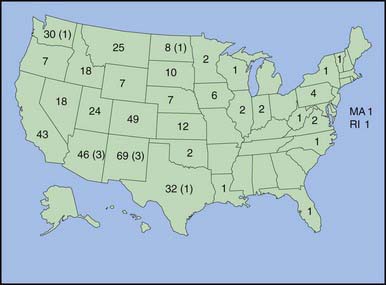Chapter 265 Hantavirus Pulmonary Syndrome
The Hantavirus pulmonary syndrome (HPS) is caused by multiple closely related hantaviruses that have been identified from the western USA, with sporadic cases reported from the eastern USA (see ![]() Fig. 265-1 on the Nelson Textbook of Pediatrics website at www.expertconsult.com) and Canada and important foci of disease in several countries in South America. HPS is characterized by a febrile prodrome followed by the rapid onset of noncardiogenic pulmonary edema and hypotension or shock. Sporadic cases in the USA caused by related viruses may manifest with renal involvement. Cases in Argentina and Chile sometimes include severe gastrointestinal hemorrhaging; nosocomial transmission has been documented in this geographic region only.
Fig. 265-1 on the Nelson Textbook of Pediatrics website at www.expertconsult.com) and Canada and important foci of disease in several countries in South America. HPS is characterized by a febrile prodrome followed by the rapid onset of noncardiogenic pulmonary edema and hypotension or shock. Sporadic cases in the USA caused by related viruses may manifest with renal involvement. Cases in Argentina and Chile sometimes include severe gastrointestinal hemorrhaging; nosocomial transmission has been documented in this geographic region only.

Figure 265-1 Total number of confirmed cases of Hantavirus pulmonary syndrome, by state of exposure—USA, 1993-2006. n = 438 as of May 10, 2006. Numbers in parentheses indicate cases confirmed during January-March 2006 (n = 9).
(From the Centers for Disease Control and Prevention: Hantavirus pulmonary syndrome: five states, 2006, MMWR Morbid Mortal Wkly Rep 55:627–628, 2006.)
Etiology
Hantaviruses are a genus in the family Bunyaviridae, which are lipid-enveloped viruses with a negative-sense RNA genome composed of 3 unique segments. Several pathogenic viruses that have been recognized within the genus include Hantaan virus, which causes the most severe form of hemorrhagic fever with renal syndrome (HFRS) seen primarily in mainland Asia; Dobrava virus, which causes the most severe form of HFRS seen primarily in the Balkans; Puumala virus, which causes a milder form of HFRS with a high proportion of subclinical infections and is prevalent in northern Europe; and Seoul virus, which results in moderate HFRS and is transmitted predominantly in Asia by urban rats or worldwide by laboratory rats. Prospect Hill virus, a Hantavirus that is widely disseminated in meadow voles in the USA, is not known to cause human disease.
HPS is associated with Sin Nombre virus, isolated from deer mice, Peromyscus maniculatus, in New Mexico. Multiple HPS-like agents isolated to date belong to a single genetic group of hantaviruses and are associated with rodents of the family Muridae, subfamily Sigmodontinae. These rodent species are restricted to the Americas, suggesting that HPS may be a Western hemisphere disease.
Epidemiology
Persons acquiring HPS generally have a history of recent outdoor exposure or live in an area with large populations of deer mice. Clusters of cases have occurred among individuals who have cleaned houses that were rodent infested. P. maniculatus is one of the most common North American mammals and, where found, is frequently the dominant member of the rodent community. About half of cases occur between the months of May and July. Patients are almost exclusively 12-70 yr of age; 60% of patients are 20-39 yr of age. Rare cases are reported in children <12 yr of age. Two thirds of patients are male, probably reflecting their greater outdoor activities. It is not known whether almost complete absence of disease in young children is a reflection of innate resistance or simply lack of exposure. Evidence of human transmission has been obtained in Argentine outbreaks.
Stay updated, free articles. Join our Telegram channel

Full access? Get Clinical Tree


